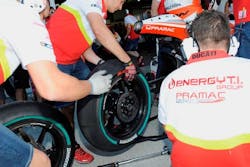Repsol Honda’s Marc Marquez celebrated his one-hundredth Grand Prix in style by winning the Spanish Grand Prix at Jerez ahead of Movistar Yamaha MotoGP’s Valentino Rossi in second place, and teammate Dani Pedrosa in third.
The race weekend at Jerez was characterized by hot ambient conditions which pushed the track temperature during each afternoon session and the race to over 122°F, which caused greasy track conditions. Despite the less than ideal track conditions in the afternoon sessions, Marquez was able to set a new Circuit Best Lap record time for Jerez of 1’38.120; beating the record set by Jorge Lorenzo in 2008 on qualifying tires.
Q&A with Masao Azuma – Chief Engineer, Bridgestone Motorsport tire Development Department
This was the first time at Jerez where the rear tire allocation was composed entirely of asymmetric slicks. How did these tires perform, and will you keep this specification of rear tire for next year’s Spanish Grand Prix?
“The decision to develop asymmetric rear slicks for Jerez was made after recent advances in our compound technology meant we could supply tires with even better warm-up performance and grip for this circuit. The main objective for supplying asymmetric rear slicks for Jerez was to improve rider safety, but it appears these new tires could also be exploited for the riders for extra performance. Over short runs they could deliver very quick pace, as shown by Marc breaking the Circuit Best Lap record from 2008 which was set on qualifying tires. The new asymmetric rears also performed well over race distance, and looking at the lap charts of many riders the difference in lap time from the start of the race to the end was only about half a second, so this shows the tires were consistent and predictable.”
All weekend the conditions were very hot, culminating in the track temperatures reaching 131°F for Sunday’s race. What effect did the heat have on tire choice for the riders, and overall tire performance?
“It is true that often when hot temperatures are encountered, that riders opt for harder compound options. At Jerez though, this wasn’t entirely the case, particularly for the rear tire. Most of the Factory Ducati, Honda and Yamaha riders went for their hardest rear tire option, but amongst the Open-class riders, it was the softer option – the extra-soft rear slick – that was most popular. The reason for this is that Jerez isn’t particularly severe on tires, so the riders knew that they could comfortably manage this option over race distance despite the heat. Also, the greasy track conditions meant that the Open-class riders wanted as much edge grip as possible and the extra-soft rear slick was the best choice in this regard.”
Bridgestone announced it will be withdrawing from MotoGP after the 2015 season, does this mean tire development will continue at the same pace over the next eighteen months as it did before?
“Yes we will still continue to develop new technologies as we want to leave the championship at the end of next season in the best way possible. It is in our interest to keep our development program going strong right until the end of our tenure in MotoGP, as there is still a lot for us to learn that we can then migrate to our range of motorcycle road tires. We are currently developing new advances in technology, particularly for the front tire that we will be providing to teams for testing purposes in the coming months. People can expect to see some state-of-the-art tire technology being introduced to the MotoGP championship over the next eighteen months. ”
Latest in Retail
Latest in Retail



